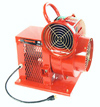Non Hazardous Location Ventilation Air Blowers
Non-hazardous-blower-ventilator-ep12acblower.jpgGeneral’s line of portable air blowers accommodate most nonhazardous confined space ventilation requirements. From 8″ to 12″ diameter units with power choices of gasoline, diesel, 12 VDC or 115 VAC. Both radial and axial housing configurations are available for the most demanding air flow applications.
Non Hazardous Location Ventilation Blower
Blowers are ideal for supplying fresh air around construction sites; removing toxic and noxious atmospheres from confined work spaces; detecting sewer line leaks and providing fresh air when working in tanks and vaults. Proper ventilation increases safety and worker productivity rates while conforming to tough federal and state OSHA regulations.
Each unit is designed to General’s highest quality standards for uncompromised utility and investment return. There are no plastic parts to crack. Constructed with heavy-gauge aluminum and steel, all General blowers offer laboratory certified air flow rates from independent, third party, agency testing. Breathe easier with a General blower on the job site… cost effective solutions to confined space ventilation.
Duct Length/ Air Flow
Due to friction loss caused by air moving against the inside surface, air flow rates decrease as duct lengths increase. For most 8″ diameter blowers, friction loss will usually limit the maximum practical duct length to 25′. Configurations requiring additional duct length or drastic directional changes can result in substantially lower air flow rates.
The 12″ diameter Model EP12AC was specifically designed to overcome the problems normally associated with longer duct lengths. The key factor is the capacity differences between 8 inch and 12 inch diameter ducts. Greater capacity means less friction loss. The EP12AC matches the power of its motor against the high static capacity of the specially-designed propeller. This combination enables the EP12AC to better overcome friction losses and deliver higher air flow rates over longer duct lengths.
The air flow rate, regardless of duct length, directly affects the total number of times per hour the atmosphere within a confined space can be properly recalculated. Federal OSHA regulations do not specify minimum air flow standards for blowers or an air recirculation requirement. However, many states have developed individual air recirculation standards that directly affect the final ventilation configuration, blower selection, duct length and even the number of blowers required. Plan any confined space entry by first determining the amount of air flow needed. Then choose the best configuration of minimize duct length and the number of directional changes. Selection of the proper ventilation will deliver the performance needed to meet any atmospheric recirculation standard.







